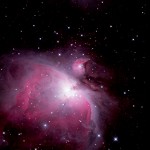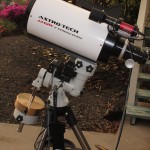The Astro-Tech 6″ RC is a wonderful little telescope… A true Ritchey–Chrétien design, at a size well matched to DSLR astrophotography. It was get one now or never, these were the last of the production run, and now they are gone.
Best of all, Astronomics was letting them go at a fire sale price… Less than $300 each!! It may have taken months on a waiting list, but I finally received one. Then it took another two months of waiting for some necessary accessories to make it work! No problem with the wait, I was patient… mostly.
With the final parts, the extension tubes, in hand. I determined to spend part of my four day Thanksgiving weekend getting the new ‘scope into service.

A few images later and things were not looking all that bad, maybe even functional. Better yet, my venerable ST-4 autoguider seemed to be tracking well. Maybe take a real picture? What to shoot? Something easy… M42 was rising over the garage… Why not? Just a test for the new setup, a fair chance something will go horribly wrong.

But still, not bad for a first real attempt.
The stars look nice across the frame, showing that the collimation is decent, always an issue with the RC design. I suspect the optical quality of the telescope is quite acceptable. The brighter star images are a bit “fat” but that is due more to the mediocre seeing over Waikoloa. After all of these years shooting with a refractor, I had forgotten how pleasing diffraction spikes can be. Better yet, with the scope positioned for north up on the tube, the spikes are neatly at 45° to the cardinal directions. I am looking forward to some more imaging sessions with a new telescope.

